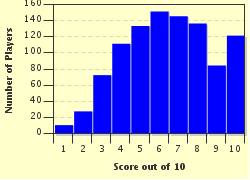Quiz Answer Key and Fun Facts
1. What is the name of the 4th degree of a scale?
2. When writing the chromatic scale on C natural, do you notate using sharps or flats?
3. The Mixolydian mode has semitones between which degrees of the scale?
4. When an interval is flipped, it becomes inverted. What is the inverse interval of an augmented 4th?
5. A major scale consists of how many major, minor, and diminished triads respectively (Excluding the upper tonic)?
6. What is a quartal chord?
7. Which of these is a non-final cadence?
8. Which of these is NOT a possible way to group hybrid triple meters?
9. Which of the following has a correct order of voice pitches, from highest to lowest?
10. Finally a question on your knowledge of instruments. The violin family consists of the violin, viola, cello, and the double bass. Which one uses the alto clef?
Source: Author
wotgoplunk
This quiz was reviewed by FunTrivia editor
ertrum before going online.
Any errors found in FunTrivia content are routinely corrected through our feedback system.


